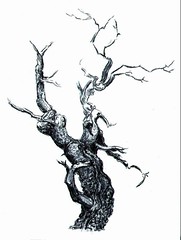By way of his many self-portraits, you can see Rembrandt's face aging - the color fading, the muscles collapsing, skin sagging and getting puffy, and his expression changing from eagerness, happiness, and even playful silliness to tiredness and resignation (and, toward the end, sometimes also a look of amusement as if he were thinking "Life didn't turn out at all like I thought it would, but you see I'm having the last laugh").
Seeing him age through these self-portraits must be especially intriguing to people who themselves are getting old, but surely Rembrandt's portraits appeal to people of all ages, no matter that the subjects may not be "beautiful" or "handsome," and it doesn't only have to do with the beautiful job of painting he did -- The very ordinariness of the people he depicted is part of their appeal (to many, not to all).
One realizes that Rembrandt painted and drew his own aging face without vanity and even with relish (though never without compassion, which he apparently felt for everyone he painted including himself), for all to see. Certainly he was interested in beauty - What artist isn't? But "beauty" means something different to different people. To Rembrandt it was the finest presentation possible of the truth.
People who know their pictures are being painted or drawn probably all hope to be depicted in such a way that they conform to society's view of how a person of their circumstances (age, sex, occupation, family role, etc. - or whichever of these things they most identify with) "should" look and I'm assuming that none of them wish to appear actually ugly. Rembrandt had to consider these things when he painted other people's portraits, but still he made them look like "real people," not slicked-up and stylized people (men all looking pretty much the same...and quite handsome, women ditto...and always beautiful). In so doing, he gave them something that a fake presentation can't muster: dignity, whether they liked it or not. He didn't leave out "imperfections" that made each person unique, though he didn't make caricatures out of them, either, nor was his point to make them ugly.
He also was able to bring out something of their character.
It seems to me that what he did was to make his subjects look like authentic, unidealized people who had the courage and dignity to accept the way they were. We are sympathetic toward them because we see them as honest people.
As for his self portraits, he could paint himself any way he wanted. He could have lied about himself, but instead he found his own odd features, and aging face, fascinating.
Apropos these thoughts, below is a relevant quote from a (very fat, very fact-filled and interesting) book I read recently by Simon Schama, called Rembrandt's Eyes:
From page 699:
"[F]or Rembrandt, imperfections are the norm of humanity. Which is why he will always speak across the centuries to those for whom art might be something other than the quest for ideal forms; to the unnumbered legions of damaged humanity who recognize, instinctively and with gratitude, Rembrandt's vision of our fallen race, with all its flaws and infirmities squarely on view, as a proper subject for picturing, and, more important, as worthy of love, of saving grace."
Below is a video that does a good "morphing" job on several of Rembrandt's self-portraits, from when he was quite young until he was an old man. It makes use of both etchings and paintings. Rembrandt starts out quite young in this video, and gets old before your eyes in just a minute or two, so that when he is an old man you still have in mind his youthful looks - This makes the effect of aging particularly poignant. Although you don't get a good look at each individual picture, you get a startling overall effect which makes you realize one reason why his paintings of people are so powerful (they are "real" people that we can identify with).
REMBRANDT'S SELF-PORTRAITS
LEFT-CLICK ON THE ARROW TO BEGIN
Time: 2 minutes, 23 seconds
After viewing the video, you may want to look at this page, titled:
Rembrandt and his Self Portraits which has many very nice reproductions of Rembrandt self-portraits. You can see the pictures clearly and take as long as you want to look at them. When you get to the page, click on a small version of the picture, or else the title of the picture, to see it in larger size. It may take a few seconds for the picture to appear then, but it does show up. There's also an article about his self-portraits, toward the bottom of the page.
_____
Free Newsletter - See bottom of this page.
1 comments:
The assembly of all of those portraits into a morphing history is quite amazing. Of course, that is mainly because of the subject and the painter who created them — Rembrandt.
Thanks for sharing that with your reflections.
Post a Comment